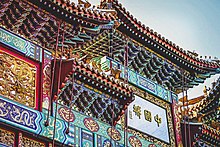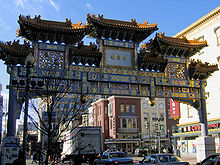
An arch is a vertical curved structure that spans an elevated space and may or may not support the weight above it, or in case of a horizontal arch like an arch dam, the hydrostatic pressure against it.

The Ming tombs are a collection of mausoleums built by the emperors of the Ming dynasty of China. The first Ming emperor's tomb is located near his capital Nanjing. However, the majority of the Ming tombs are located in a cluster near Beijing and collectively known as the Thirteen Tombs of the Ming dynasty. They are located within the suburban Changping District of Beijing Municipality, 42 kilometers (26 mi) north-northwest of Beijing's city center. The site, on the southern slope of Tianshou Mountain, was chosen based on the principles of feng shui by the third Ming emperor, the Yongle Emperor. After the construction of the Imperial Palace in 1420, the Yongle Emperor selected his burial site and created his own mausoleum. The subsequent emperors placed their tombs in the same valley.
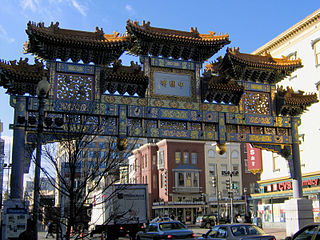
Washington, D.C.'s Chinatown is a small, historic area east of Downtown Washington, D.C. along H and I Streets between 5th and 8th Streets, Northwest. The area was once home to thousands of Chinese immigrants, but fewer than 300 remained in 2017. The current neighborhood was the second in Washington to be called “Chinatown” since 1931. Originally, the first Chinatown was built in the Federal Triangle on the south side of Pennsylvania Avenue some time after 1851, but was moved to the H Street area when a new federal building was built there. In 1986, a Chinese gate was built over H Street at 7th Street. By 1997, prominent landmarks such as the Capital One Arena, a sports and entertainment arena, had gentrified the area. The neighborhood is served by the Gallery Place station of the Washington Metro.

Chinese architecture (Chinese:中國建築) is the embodiment of an architectural style that has developed over millennia in China and it has influenced architecture throughout Eastern Asia. Since its emergence during the early ancient era, the structural principles of its architecture have remained largely unchanged. The main changes involved diverse decorative details. Starting with the Tang dynasty, Chinese architecture has had a major influence on the architectural styles of Japan, Korea, Mongolia, and Vietnam, and minor influences on the architecture of Southeast and South Asia including the countries of Malaysia, Singapore, Indonesia, Sri Lanka, Thailand, Laos, Cambodia and the Philippines.
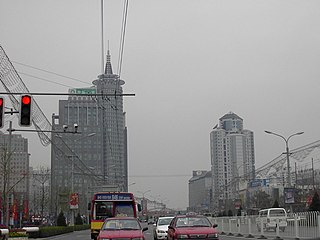
Chaoyangmen Outer Street is a major through route in Beijing, China, and runs through the Chaowai area near Chaoyangmen. Geographically, it is in the eastern urban area, and is still considered very close to the city centre even though it lies outside the 2nd Ring Road. It is north of a similarly significant area, the future Beijing CBD.

A paifang, also known as a pailou, is a traditional style of Chinese architectural arch or gateway structure.

Philadelphia Chinatown is a predominantly Asian American neighborhood in Center City, Philadelphia. The Philadelphia Chinatown Development Corporation supports the area. The neighborhood stretches from Vine Street on the north; Arch Street on the south; North Franklin Street and North 7th Street on the east; to North Broad Street on the west.

The Pui Tak Center, formerly known as the On Leong Merchants Association Building, is a building located in Chicago's Chinatown. Designed by architects Christian S. Michaelsen and Sigurd A. Rognstad, the building was built for the On Leong Merchants Association and opened in 1928. The Association used it as an immigrant assistance center, and the building was informally referred to as Chinatown's "city hall". In 1988, the FBI and Chicago Police raided the building as part of a racketeering investigation. The US federal government seized the building that same year.

The Beijing city fortifications were series of walls with towers and gates constructed in the city of Beijing, China in the early 1400s until they were partially demolished in 1965 for the construction of the 2nd Ring Road and Line 2 of the Beijing Subway. The original walls were preserved in the southeastern part of the city, just south of the Beijing railway station. The entire perimeter of the Inner and Outer city walls stretched for approximately 60 kilometres (37 mi).

Hing Hay Park is a 0.64-acre (2,600 m2) public park in the Chinatown–International District neighborhood of downtown Seattle, Washington, United States. The park is located on the north side of South King Street between 6th and Maynard avenues, east of Union Station and the Historic Chinatown Gate. It was built in 1973 and includes a pavilion, community games, and two gateways.

The Chinese Garden of Friendship is a heritage-listed 1.03-hectare (3-acre) Chinese garden at 1 Harbour Street, in the Sydney Central Business District, City of Sydney, New South Wales, Australia. Modelled after the classic private gardens of the Ming dynasty, the garden offers an insight into Chinese heritage and culture. It was designed by Guangzhou Garden Planning & Building Design Institute, Tsang & Lee, and Edmond Bull & Corkery and built from 1986 to 1988 by Gutteridge Haskins & Davey; the Darling Harbour Authority; Imperial Gardens; Leightons; and Australian Native Landscapes. The gardens were added to the New South Wales State Heritage Register on 5 October 2018.
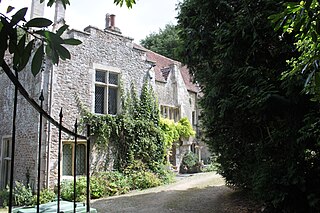
The Abbey, Beckington in Beckington, Somerset, England is a historic building that was founded as a monastic grange and also used as a college for priests; the building was begun in 1502, but after the Dissolution of the Monasteries it became a private house. It was altered in the early 17th century with a new front and a sumptuous barrel vaulted plaster ceiling, and also altered in the 19th century. The house was used as a school, restaurant and dance hall in 19th and 20th centuries but has now been restored as three houses: the most important plaster ceiling is in the house now known as "The Abbey".

Chinatown in Manchester, England, is the second largest Chinatown in the United Kingdom and the third largest in Europe. Its archway was completed in 1987 on Faulkner Street in Manchester city centre, which contains Chinese restaurants, shops, bakeries and supermarkets.
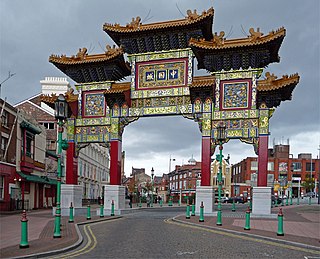
Chinatown is an area of Liverpool that is an ethnic enclave home to the oldest Chinese community in Europe. Located in the south of the city centre, Chinatown has many Chinese businesses, such as Chinese restaurants and supermarkets, and facilities for the Chinese community. The area is also notable for its Chinese-style architecture; with the paifang on Nelson Street being the largest, multiple-span arch of its kind outside China.

The Chinese Cultural Center, now the Outlier Center, was a Chinese-themed retail complex in Phoenix, Arizona. It was developed in 1997 by BNU Corporation, a subsidiary of COFCO, a Chinese state-run enterprise and the country's largest food processor, manufacturer and trader. Although the center was developed as a for-profit investment by its owners, it was portrayed as a "cultural center" for the Chinese community in the greater Phoenix area. The developers thought the traditional Chinese architecture and landscaping, its concentration of Chinese-related businesses, and its use as a venue for celebrating Chinese holidays would attract both tourists and local Asian-Americans, and make Chinese business people feel more at home and welcome in Phoenix, thus helping Phoenix attract more foreign investment. The center opened in 1998 with visual elements imported from China and installed by Chinese craftsmen. It struggled with low occupancy, suffered further during the recession of the mid-2000s, and never recovered. In 2017, a new owner announced the property would be repurposed as a modern office building and the distinctive Chinese roof would be removed. This led to a sustained multi-year effort by the Chinese-American community to block the redevelopment and preserve the center as it was built. Despite demonstrations, petitions, lobbying, and several lawsuits, the new owner ultimately prevailed and all Chinese elements were gone by 2022.
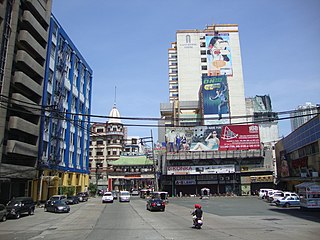
Plaza Moraga is a public square in Manila, Philippines. Serving as the gateway to Manila's Chinatown of Binondo, the plaza is located at the foot of Jones Bridge at the west end of Escolta Street. It was named after a Franciscan friar, Fr. Fernando de Moraga and it is by the opinion of many, that were it not for him, the history of the Philippines would turn out differently from what it is now.

Chinatown Gateway is an outdoor paifang and sculpture which serves as an entrance to Portland, Oregon's Old Town Chinatown neighborhood, in the United States. The gate was proposed by the Chinese Consolidated Benevolent Association in 1984. Architect Yu Tang Wang and artist Sun Chau completed the gate's design, which was built by Ting Hwa Architects in Taiwan. It was then shipped to Portland and installed in one week before being dedicated in November 1986. It cost $256,000 and was the largest of its kind in the United States until one in Washington, D.C. was completed several months later.

The Historic Chinatown Gate is a modern Paifang archway in the Chinatown-International District neighborhood of Seattle, Washington.

The Dragon Gate is a south-facing gate at the intersection of Bush Street and Grant Avenue, marking a southern entrance to San Francisco's Chinatown, in the U.S. state of California. Built in 1969 as a gift from the Republic of China (Taiwan) in the style of a traditional Chinese pailou, it became one of the most photographed locations in Chinatown, along with the older Sing Fat and Sing Chong buildings.

The Grand Mosque of Meknes is the historic main mosque of the old city (medina) of Meknes, Morocco. It is the largest and most important mosque in the old city and one of its oldest monuments.


